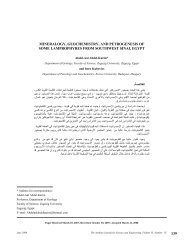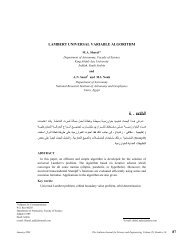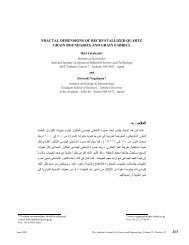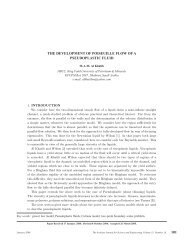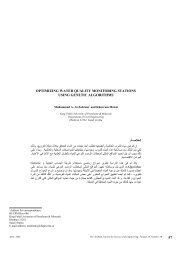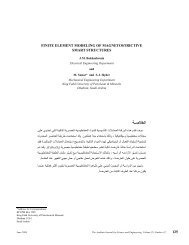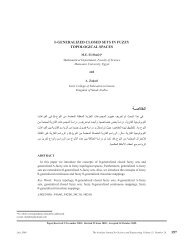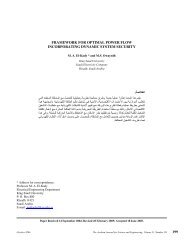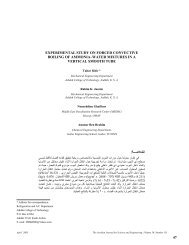Origin of Iron-Rich Beds in the Basal Wajid Sandstone, Abha…
Origin of Iron-Rich Beds in the Basal Wajid Sandstone, Abha…
Origin of Iron-Rich Beds in the Basal Wajid Sandstone, Abha…
Create successful ePaper yourself
Turn your PDF publications into a flip-book with our unique Google optimized e-Paper software.
L.O. Babalola, M. Hussa<strong>in</strong>, and M.M. Hariri<br />
Stump and van der Eem [3] <strong>in</strong>vestigated <strong>the</strong> tectonic and sedimentation history <strong>of</strong> <strong>the</strong> <strong>Wajid</strong> <strong>Sandstone</strong> outcrop belt <strong>in</strong><br />
<strong>the</strong> southwestern Saudi Arabia. Accord<strong>in</strong>g to <strong>the</strong>m, <strong>the</strong> <strong>Wajid</strong> <strong>Sandstone</strong> <strong>in</strong> <strong>the</strong> area is represented by a variety <strong>of</strong> facies<br />
<strong>in</strong>clud<strong>in</strong>g shallow-mar<strong>in</strong>e, lagoon, braided river, fluviatile deltaic, and eolian. Greenwood [4], described a 235 m thick,<br />
tabular to wedge shaped, cross-bedded light brown to reddish–brown quartz-rich sandstone, characterized by iron-oxide<br />
concretions and layers.<br />
The <strong>Wajid</strong> <strong>Sandstone</strong> <strong>in</strong> <strong>the</strong> study area is represented by an approximately 300 m thick sequence <strong>of</strong> dom<strong>in</strong>antly coarse-<br />
to medium-gra<strong>in</strong>ed massive to cross-bedded sandstone and kaol<strong>in</strong>ite-rich silty claystone. Based ma<strong>in</strong>ly on <strong>the</strong> color and<br />
distribution <strong>of</strong> iron-rich horizons, <strong>the</strong> succession is <strong>in</strong>formally divided <strong>in</strong>to two units; a Red Unit (basal) and a Grey Unit,<br />
Figure 2 [5, 6]. The Red Unit composed <strong>of</strong> alternat<strong>in</strong>g successions <strong>of</strong> dom<strong>in</strong>antly red–p<strong>in</strong>k, occasionally brick red, grey<br />
to white, massive to cross-bedded sandstone with ironstone and kaol<strong>in</strong>ite-rich claystone horizons. The Red Unit is<br />
separated from <strong>the</strong> overly<strong>in</strong>g Grey Unit by an approximately 50 cm to 1 m thick conglomerate bed, compris<strong>in</strong>g quartz<br />
and claystone clasts rang<strong>in</strong>g <strong>in</strong> size from few mm to up to 10 cm. The Grey Unit is composed <strong>of</strong> a monotonous sequence<br />
<strong>of</strong> white–greyish, pebbly, coarse to medium, occasionally f<strong>in</strong>e-gra<strong>in</strong>ed, massive to cross-bedded sandstone. This unit is<br />
rich <strong>in</strong> white, friable kaol<strong>in</strong>ite lenses and <strong>in</strong>traformational claystone clasts. <strong>Iron</strong>-rich beds observed are not common <strong>in</strong><br />
<strong>the</strong> Grey Unit.<br />
Figure 2. Stratigraphic column show<strong>in</strong>g <strong>the</strong> lithology <strong>of</strong> <strong>the</strong> <strong>Wajid</strong> <strong>Sandstone</strong>. In <strong>the</strong> study area, <strong>the</strong> <strong>Wajid</strong> <strong>Sandstone</strong> non-conformably<br />
overlies <strong>the</strong> Precambrian basement complex.<br />
January 2003 The Arabian Journal for Science and Eng<strong>in</strong>eer<strong>in</strong>g, Volume 28, Number 1A. 7



